Abstract: This paper analyzes the changes in traffic from Facebook to non- profit news organizations before and after the major change to the Facebook News Feed in January 2018, implemented in response to the controversy over fake news dissemination from Russian meddling in the 2016 presidential election in the United States. We find that while the organizations in our cohort generally experienced a decline in referral traffic from Facebook, it was more varied than the declines reported among larger, commercial press outlets that released their own Facebook referral data. We speculate that the variation and lower overall decline may be due to how nonprofit news organizations’ stories are shared on Facebook. Further, we suggest additional research into both the best practices of Facebook sharing for nonprofit news organizations and how they can siphon additional control of their content distribution from third-party technology platforms to their own.
Click here to read and download a PDF version of this paper.
1. Introduction
In 2006, Facebook created a new product that would profoundly alter the news-consuming habits of many, shift how news organizations thought about distributing digital content, and even influence the course of elections and modern democracy. The company introduced the “News Feed,” as a central place where a user could see all the changes that had happened on the social network while they had been away (Sanghvi 2006). It began with updates such as who had become friends with whom, which groups users had joined, or (always popular with college students) who had changed their relationship status. As Slate’s senior technology reporter Will Oremus put it, the News Feed was “a hub for updates about your friends’ activities on the site” (Oremus 2016).
1.1 Background
As the product grew, more content appeared in the News Feed, including material which had been posted by organizations (Murphy 2013). In addition to incorporating more posts from more places in its News Feed, Facebook also developed new ways to determine how to rank and display them (Oremus 2016). The most important “signal” that Facebook engineers used to determine the value of a given post was the then-new (2009) “like” button, which users could click if they, well, liked a status update by a friend or a story from a publisher. Oremus explained:
The like button wasn’t just a new way for users to interact on the site. It was a way for Facebook to enlist its users in solving the problem of how best to filter their own news feeds. That users didn’t realize they were doing this was perhaps the most ingenious part. If Facebook had told users they had to rank and review their friends’ posts to help the company determine how many other people should see them, we would have found the process tedious and distracting. Facebook’s news feed algorithm was one of the first to surreptitiously enlist users in personalizing their experience—and influencing everyone else’s (Oremus 2016) [1]
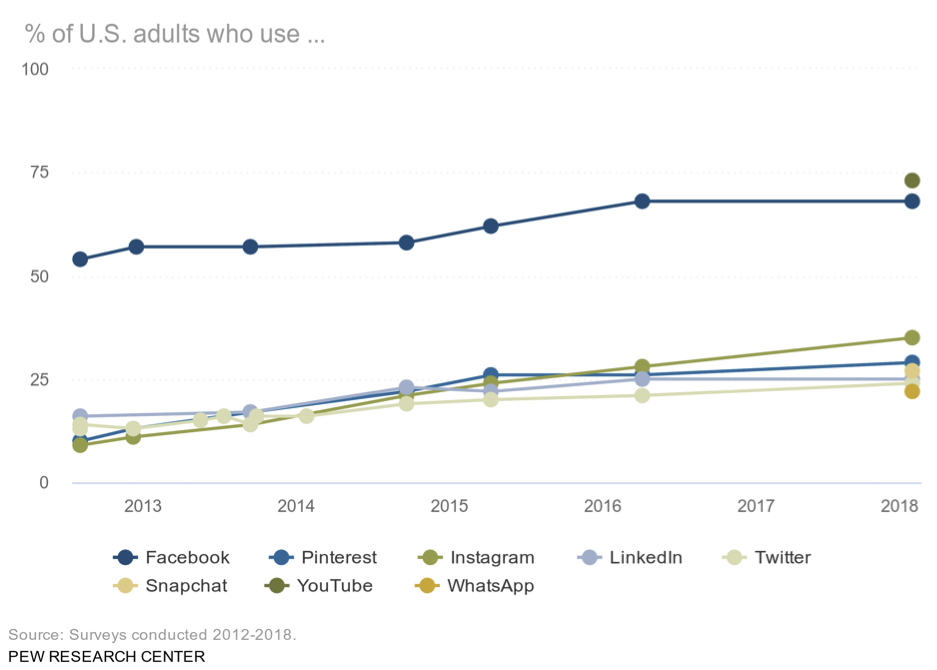
Figure 1: Top social media usage in the U.S. as measured by Pew (Demographics of Social Media Users and Adoption in the United States 2018).
When Facebook expanded from a network for college students to one of the largest social networks [see Figure 1 for U.S. social media usage over time (Demographics of Social Media Users and Adoption in the United States 2018)], news organizations discovered they could use it to grow their audiences. Indeed, social sharing of news, particularly on Facebook, became so popular that it shifted how news sites were built. For example, organizations realized that most traffic came “in the side door” and started adding links to related or new stories at the bottom of a page, almost as if creating a miniature home page (Seward 2014).
As Facebook continued to optimize its News Feed for posts that people liked or clicked, etc., and news organizations continued to optimize their own posts for traffic (clicks) from that feed, Facebook became an exceptionally valuable source of traffic for many publishers. As The New York Times Magazine’s John Herrman summarized in his profile “Inside Facebook’s (Totally Insane, Unintentionally Gigantic, Hyperpartisan) Political-Media Machine”:
Facebook, from a publisher’s perspective, had seized the web’s means of distribution by popular demand. A new reality set in, as a social media network became an intermediary between publishers and their audiences. For media companies, the ability to reach an audience is fundamentally altered, made greater in some ways and in others more challenging. For a dedicated Facebook user, a vast array of sources, spanning multiple media and industries, is now processed through the same interface and sorting mechanism, alongside updates from friends, family, brands and celebrities (Herrman 2016).
Those other updates, from non-news entities masquerading as news organizations, were at the very moment of that profile, a significant and still sub-rosa problem for Facebook.
1.2 January 2018 Changes
In the wake of the 2016 presidential election in the U.S., it came to light that Russian government entities had used Facebook and posts in users’ News Feeds to sow discord and disinformation in and among the American electorate in an explicit attempt to influence its outcome (Isaac and Wakabayashi 2017). As a result, and under extreme public pressure, Facebook made significant changes to how the News Feed algorithm ranked posts. On January 11, 2018, Facebook’s head of News Feed, Adam Mosseri, announced that the company would “prioritize posts from friends and family over public content … including videos and other posts from publishers or businesses,” via their Pages (Mosseri 2018). He continued:
As we make these updates, Pages may see their reach, video watch time and referral traffic decrease. The impact will vary from Page to Page, driven by factors including the type of content they produce and how people interact with it. Pages making posts that people generally don’t react to or comment on could see the biggest decreases in distribution. Pages whose posts prompt conversations between friends will see less of an effect (Mosseri 2018).
1.3 Anecdotal Reports of Traffic Reductions
The first signs that this change might have had a significant impact on publishers started to appear in February 2018. In Digiday, Lucia Moses wrote that “Chartbeat data showed Facebook traffic to publishers declined 6 percent since the beginning of January.” Moses added that other proprietary tools from PopSugar and True Anthem suggested both modest declines in Facebook referrals for some publishers and increases for others, just one month after the changes (Moses 2018).
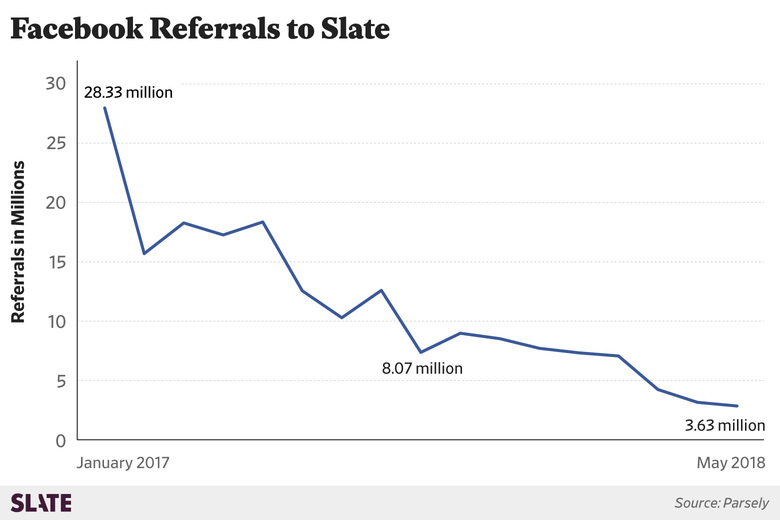
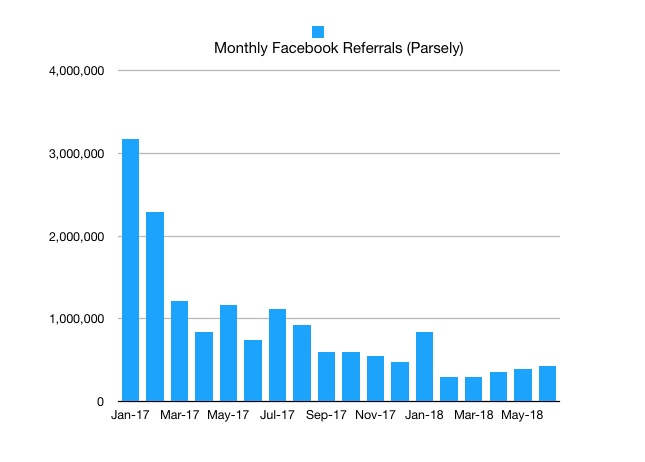
Figure 2: Referrals from both Slate and Talking Points Memo decreased during the period between January 2017 and June 2018. Both organizations also saw downward referral trends following Facebook’s algorithm change in January 2018 (Oremus 2018; Marshall 2018).
At the end of February, LittleThings, a publication focused on “a mix of feel-good news and service content” for women, shut down, citing the algorithm change as the key reason (Shields 2018).[2] LittleThings’ CEO said its organic (non-paid) traffic from Facebook dropped 75 percent, noting that “no previous algorithm update ever came close to this level of decimation” (Ha 2018).
Public conversation kicked off again in June 2018 when Slate published a large feature on the impact these changes had on its Facebook referral traffic. The results, it said, were devastating. The story noted that “for every five people that Facebook used to send to Slate about a year ago, it now sends less than one” (Oremus 2018). Slate also published a summary chart from its analytics provider, shown in Figure 2a, which illustrates how traffic to Slate from Facebook had been on the decline since January 2017, and took another dip after the January 2018 News Feed changes. Other publishers followed suit, including, for example, Josh Marshall at Talking Points Memo. His data, shown in Figure 2b, showed similar decreases in traffic from Facebook since the beginning of 2017 (with a small uptick after an extreme drop in February 2018) (Marshall 2018).
1.4 Research Question
Given the public conversation around significant changes in Facebook referral traffic, we wanted to understand what happened for nonprofit news publishers, especially since they are a rapidly growing segment of the news ecosystem (Lewis 2018), and a core part of our research at the Shorenstein Center.[3]
Put simply, this paper aims to investigate: What happened to referral traffic from Facebook to nonprofit news organizations after the January 2018 News Feed changes?
This is particularly interesting to investigate because, unlike outlets such as Slate, these organizations depend less on raw traffic numbers for revenue. Instead, traffic and social interactions are measures of whether or not these entities are having the kind of social impact intended. It’s not that traffic numbers are entirely unrelated to revenue—for example, they are certainly used to attract fundraising from foundations—but more that they are not directly tied to revenue in the same way they may be at primarily advertising-supported publications.[4]
In section 2, we identify the available data, selection methodology, and analysis tools we use for this paper.
2. Methods
2.1 Cohort
In order to better understand the impact of the News Feed changes on non- profit publishers, we collected data from a cohort of eight news organizations, grouped into two categories: investigative and single-subject. The investigative group focuses on producing investigative journalism on a wide array of topics, all in the national interest; whereas the single-subject group may produce investigative journalism, it’s all in the context of a single subject. The three investigative organizations are: the Center for Public Integrity, ProPublica, and Reveal from The Center for Investigative Reporting. The five single-subject organizations are: Chalkbeat, The Hechinger Report, The Marshall Project, The Trace, and The War Horse. 
Table 1: The eight organizations that make up the cohort for this study.
The investigative organizations represent large subject areas and are unified more in their methodology and scope than in the specific subject matter they discuss. Further, they distinguish themselves from the single-subject group through the depth of reporting and analysis given to each individual story. Conversely, the single-subject publishers may provide significantly more depth on a specific topic over time, and may even have radically more reporting in any individual story. However, they are differentiated in that they use multiple methods to cover the same topic over a long period of time. In the same way that investigative organizations are unified by method, so too are the single-subject publishers.
The complete cohort for this study, along with the relevant areas of focus, are listed alphabetically in Table 1.
It should be noted that while this is an extremely small sample of organizations, and we do not suggest that it is broadly representative, we do find the data to be of value. Primarily, it is from more organizations than have previously been made public, and from a particular market segment that is not only growing but has the potential to be normatively beneficial for American democracy.
2.2 Data Sources
The data for this study was collected from Google Analytics and Data Studio, both part of the Google Marketing Platform.[5] Google Analytics runs a small JavaScript in the web browser of each visitor, which records data about pages visited, time on site, characteristics of the computer visiting, etc. Google Data Studio can extract data from multiple Google Analytics properties (accounts) and run statistics on them together—a critical function for our research. We selected the Google Marketing Platform for two key reasons. First, each of the organizations in our cohort already had Google Analytics installed on its website. Second, by using the same system across each cohort member, we could ensure that these data points were comparable. Further, if Google Analytics systematically under- or over-counts any particular metric, it should do so similarly for each cohort member. As noted above in regard to our small sample size, we also note here that using Google Analytics as a data source is also a limited view into what is happening within Facebook. For example, it cannot track other factors—such as the number of “likes” an organization’s Facebook page receives—which might also impact referrals.[6]
To collect data, we created a “channel” within Google Analytics, which are “groupings of … traffic sources,” which we applied to each organization (About Channel Groupings 2018). Our channel searched for as many permutations of Facebook domains as possible in order to capture all traffic, including that which originated from mobile devices. We used facebook. com, developers.facebook.com, en-gb.facebook.com, l.facebook.com, lm.facebook.com, m.facebook.com, mtouch.facebook.com, and touch.facebook.com in our channel definition.
In addition, for other analyses, we utilized the default channels in Google Analytics. These include: Affiliates, Direct, Display, Email, Organic Search, Other, Other Advertising, Paid Search, Referral, and Social; these channels are defined in the Google Analytics documentation,[7] but are primarily the common use of the terms. For example, “Social” would include traffic from Facebook, but not from a WordPress hosted blog. Further, some of the channels are not listed in our tables and figures because they were not present in the data for our cohort (e.g., Affiliates, Display, and Other Advertising).

Figure 3: Google Analytics uses this figure in its documentation to illustrate how sessions can be viewed as a wrapper around a set of activities and events (How a session is defined in Analytics 2018).
2.2.1 Key Metrics: Sessions and Users
For analysis, we selected two primary metrics: sessions and users. Together these helped us to create a picture of the traffic from Facebook to each news organization’s website.
Sessions are defined as “a group of user interactions with [a] website that take place within a given time frame [30 minutes]. … a session [is] the container for the actions a user takes on your site” (Pageview 2018). Thus, a session can contain multiple activities. Google uses the diagram shown in Figure 3 to illustrate the concept of a session. Sessions are a particularly useful metric to answer our research question because they group the number of times someone comes to a site and browses around as a result of a link from Facebook. Sessions is more instructive than the raw number of page views,[8] because our interest is not in the total volume of articles read, but how much traffic is flowing from Facebook to each of the news organizations’ sites.
Google Analytics defines users as “how many users are engaged with your site” (How users are identified for users metrics 2018). To do so, Analytics assigns a unique identifier to each user, which is transmitted with each page view and estimates that the error rate is “typically less than 2%” (How users are identified for users metrics 2018). Users helps us to understand what sessions alone does not: the number of people who generate those sets of interactions.
As such, together, the counts of sessions and users creates a full picture of the traffic visiting the websites in our cohort from Facebook. They show both the count of individuals and the average depth of their interaction. For example, a single user might be responsible for five sessions over a given period of time.
2.2.2 A Note on Data from Google Analytics
Google Analytics is not a static store of previously recorded data. The company continually tunes its algorithms and samples the data it has collected, meaning that running to the same query at a different time might result in the display of different data (About Data Sampling 2018).
Further, due to the flexibility of Google Analytics, it is possible to configure the tool in many different ways. We encountered two organizations that were set up differently than the other six, coded for anonymity as S-C and S-D. These organizations configured permissions such that source traffic data is based on a sample of the data instead of a count of every session and user. Google Analytics estimated the traffic sources for S-C with 25 percent and S-D with 35 percent of available data. This sampled data is used throughout the paper whenever we reference a traffic channel. However, we were able to determine the accurate count of total sessions and users without sampling. Further, this does not impact our labeling of referral traffic from Facebook, as discussed in subsection 3.2, because this was a custom query that pulled complete, non-sampled data for each organization.
3. Results
Below we present the results of our analysis. In order to protect the privacy of our cohort members, we have anonymized the data by presenting a code instead of the organization’s name. We use the same code for each organization throughout the paper, and we differentiate between investigative and single-subject organizations by the prefix I- and S-, respectively. We also present percent change data instead of raw counts of metrics.
3.1 Traffic Sources in Context
In order to understand the role of traffic from Facebook, we began by examining all traffic to each organization.

Table 2: Percent change in total users and sessions at each organization in the cohort in the three months before and after the News Feed modifications.
First, we looked at the change in total users and sessions in the three months prior to and after the News Feed change. These results are presented in Table 2. In the three months after the changes, the investigative organizations saw small changes in both metrics, whereas the entire single-subject cohort saw growth. In almost all cases, both metrics move together—that is, they show approximately the same percent change in users and sessions. This is simply explained: adding more users doesn’t change the typical user behavior. Each user is still coming roughly the same number of times as older ones. There are two outliers in the case of the single-subject cohort: S-A and S-E. In the case of S-A, the number of sessions grew only about half as much as the number of users. One potential explanation of this is that a burst of new users arrived to see a single piece and never returned. In the case of S-E, growth was very robust.[9]
Next, using Google Analytics’ acquisition report, we examined the overall composition of traffic to each member of the cohort. We present the results of this analysis in Figure 4, Figure 5, and Table 3 using our metrics of users and sessions, respectively. In both figures, we show the composition of traffic for the three months prior to and three months after News Feed changes. Traffic is grouped using the default Google Analytics channels: Direct, Email, Organic Search, Other, Referral, and Social. In the table, we show the percentage change over the same time period, and in the same categories. Cells with growth over the period are filled in green, whereas those with loss are red, for legibility.

Table 3: Percentage change in the three months pre- and post-News Feed change, by Google Analytics channel, for users and sessions. Decreases appear red, and increases appear green.
Some of the changes in traffic by channel were highly consistent across every member of the cohort, as shown in Table 3. Referral traffic was most consistent; it increased users visiting the entire cohort, and increased sessions for all but I-C, where they were down ≈2%. Organic search traffic was also extremely consistent; it grew in terms of users and sessions for every organization except I-B, where users were down ≈3% and sessions ≈5.5%. Also consistent, and expected, was a decrease in traffic from social media. Just two organizations saw growth in terms of users and sessions: S-B and S-E. As noted above, however, S-E saw large growth across all channels.
3.2 Facebook Referral Data
Referral traffic from Facebook for our cohort was very similar to that of all social media referral traffic. Comparing the social referrals from Table 3 (which consist of Facebook in addition to other social media) and the extracted Facebook referrals in Table 4, we saw only one discrepancy, I-B, which experienced very small losses from social media overall and slight gains from Facebook.

Table 4: Percent change in referrals from Facebook by users and sessions at each organization in the cohort in the three months before and after the News Feed modifications.
However, when looking for a trend across organizations, the most notable feature of the data is its inconsistency. Three organizations (I-C, S-A, and S-D) saw declines of ≈30% in terms of users and sessions from Facebook, where two (I-A and S-C) were ≈10%. Of the three organizations that saw growth in referrals from Facebook, S-B saw marginal improvement in users, at ≈2% but larger lift in terms of sessions, at ≈5%.[10] I-B saw low growth with a lift of ≈10% in users and ≈6% in sessions from Facebook. And S-E, the outlier of the cohort, saw users grow ≈54% and sessions by ≈49.5% from Facebook.
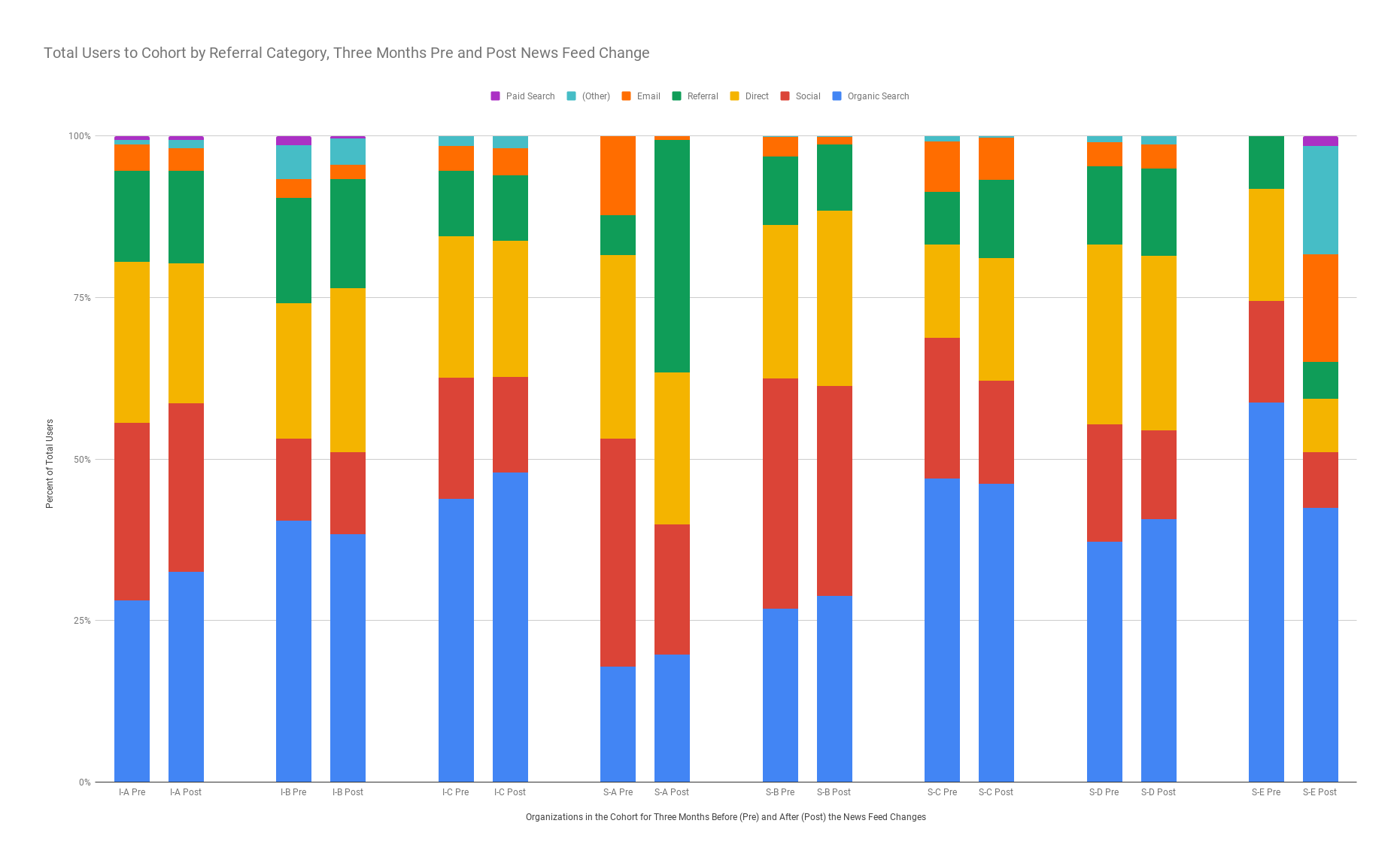
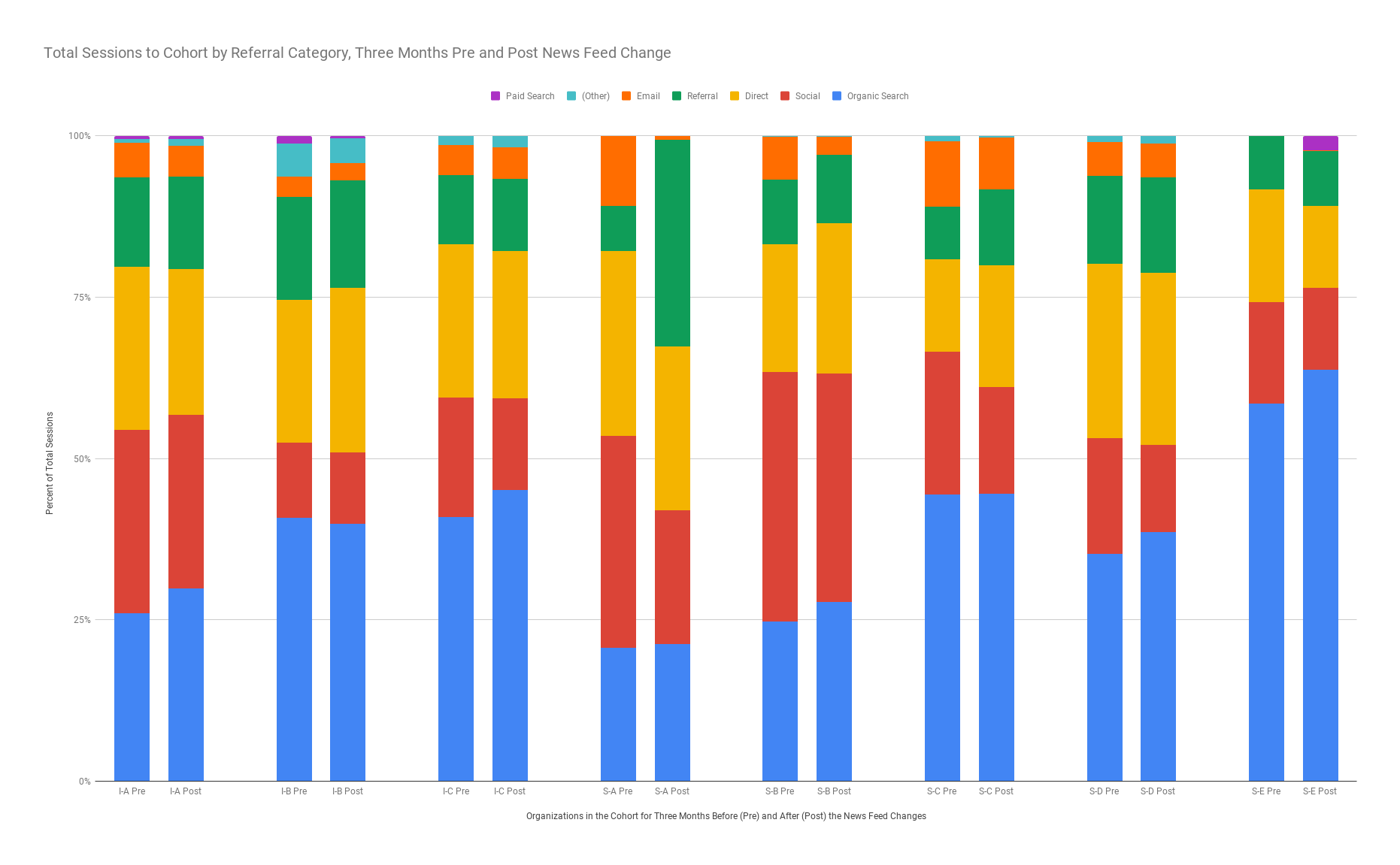
4. Conclusions and Future Research
The data from our cohort of nonprofit publishers agrees generally with the public anecdotes told by and about Facebook’s News Feed change: referral traffic did decrease. However, it also shows significantly more nuance than has been published previously. Whereas Slate and Talking Points Memo saw precipitous drops, the publishers in this cohort saw mild to moderate ones. Further, the data shows that, on the whole, the organizations in our cohort continued to grow in the face of these changes, and that there was large variation in what could be expected from Facebook.
If, as the Shorenstein Center does, one believes that nonprofit publishers are to play an important role in the future of our journalism ecosystem, this is an undeniable good. Regardless of the actions of a large technology company—which no news organization could ever hope to control—there are paths to growth and serving an audience.
That said, due to the extremely large variation in the experience of each organization in our cohort, more research is required. Still, two speculative conclusions stand out.
First, if one takes Facebook’s change announcement at face value, it could be that it was never intended to impact this group of publishers. If, for example, the primary way that the organization’s links are shared on Facebook is by users instead of by the organization’s own page, its standing in the News Feed could improve as a result of this change. Put another way, it could be that these organizations were not equipped to game the system in the way that larger publishers could. Indeed, in the same piece where Oremus lamented the decline in Facebook traffic, he explained how the company actively bought traffic using various intermediaries, all of which contributed to Facebook referrals (Oremus 2018). In the case of this nonprofit cohort, some did attempt to buy traffic, but it was on an incredibly small scale, as shown in Figure 4 and Figure 5. Further research, perhaps incorporating data from Facebook’s own CrowdTangle tool, would be particularly helpful. It could, perhaps, help small organizations understand how to encourage the right kind of social sharing by their audience. It would also be extremely useful to conduct preliminary research on the methods that small news organizations could use to conduct these experiments (on how to best use the Facebook News Feed for growing traffic) on their own. One could imagine a repository of methods that helps publications learn which kinds of advertising A/B tests to run and what to learn from them.
Second, obviously, other acquisition strategies are taking the place of Facebook. Email is of particular interest to the Shorenstein Center, as is the referral data presented in Table 3. While not universal, S-E shows growth in traffic from email. This corresponds with Shorenstein Center experiments in improving each of the cohort’s email newsletters.[11] Further, as highlighted by Jacque Boltik’s 2017 analysis, the value of email as a traffic source is that it can be controlled by the news organization in a much more significant way than other technology platforms (Boltik and Mele 2017).

Table 5: Percentage change in the three months pre- and post-News Feed change, combining the Direct, Email, Search, and Social Google Analytics channels. Direct and Email are more directly controlled by the news organizations themselves than Search and Social.
To that end, we asked: what happened to traffic controlled by our cohort members versus that sent by platforms? The results, shown in Table 5, were not as enlightening as we had hoped. While these groupings may be a useful management tool—consistent growth in Direct and Email traffic could be expected almost regardless of the vagueries of a platform’s algorithmic change du jour—in the case of our cohort, there was little consistency.
A real-world experiment to determine the extent to which nonprofit news organizations could use social media platforms to drive email capture and a separate relationship with readers would be another useful piece of future research.
Notes
1. For more on how the News Feed itself works, and how it was developed, Oremus’s 2016 piece for Slate is highly instructive.
2. The assets of LittleThings were later purchased by a mobile gaming company, which relaunched the publisher. For more, see Mike Shields’s reporting in Business Insider (Shields 2018).
3. https://shorensteincenter.org/single-subject-news-sites-engagement/
4. For a detailed discussion on the role that organizations like those in our cohort are playing in a broader news ecosystem, see the “Guide to Audience Revenue and Engagement” (Hansen and Goligoski 2018).
5.In the middle of 2018, Google re-branded many of its marketing- related tools under the banner brand “Google Marketing Platform,” https://marketingplatform.google.com/about/
6. For a more in-depth discussion of the epistemology of case selection, see Robert Stake’s concept of the “opportunity to learn” (Stake 2005). We follow Stake’s opportunity to learn in that we define it as the ability to gain access to data.
7. See https://support.google.com/analytics/answer/3297892.
8. Google defines these as “an instance of a page being loaded (or reloaded) in a browser” (Pageview 2018).
9. The growth at this publisher was across nearly every metric available and is attributable to a major news story of national interest, in its subject area, that occurred after the News Feed change. Perhaps most interesting about this is the robustness of growth in search referrals for S-E, suggesting that people sought out information on the news topic and found S-E as a source.
10. This is an interesting combination, as it suggests that S-B has found a way to get its current readers to come back more often.
11. See, for example, the report on the December 2017 Shorenstein conference on email newsletters for the cohort, by Emily Roseman, available on Medium: https://medium.com/single-subject-new-project/six-lessons-about-email-and-audience-growth-for-nonprofit-news-e05b8ea46a63
References
About Channel Groupings. 2018. Google Analytics Help. Accessed July 27. https://support.google.com/analytics/answer/6010097.
About Data Sampling. 2018. Google Analytics Help. Accessed July 29. https://support.google.com/analytics/answer/2637192.
Boltik, Jacque, and Nicco Mele. 2017. Using Data Science Tools for Email Audience Analysis. Shorenstein Center on Media, Politics & Public Policy, October. Accessed July 13, 2018.
https: //shorensteincenter.org/email-analysis-research-guide/.
Demographics of Social Media Users and Adoption in the United States. 2018. Pew Research Center. Accessed August 8. http://www.pewinternet.org/fact-sheet/social-media/.
Ha, Anthony. 2018. LittleThings Blames Its Shutdown on Facebook Algorithm Change. TechCrunch, February. Accessed August 9, 2018. https://techcrunch.com/2018/02/28/littlethings-shutdown/.
Hansen, Elizabeth, and Emily Goligoski. 2018. Guide To Audience Revenue and Engagement. Columbia Journalism Review, February. Accessed October 9, 2018. https://www.cjr.org/tow_center_reports/guide-to-audience-revenue-and-engagement.php.
Herrman, John. 2016. Inside Facebook’s (Totally Insane, Unintentionally Gigantic, Hyperpartisan) Political Media Machine. The New York Times Magazine, August. Accessed August 8, 2018. https://www.nytimes.com/2016/08/28/magazine/inside-facebooks-totally-insane-unintentionally-gigantic-hyperpartisan-political-media-machine.html.
How a session is defined in Analytics. 2018. Google Analytics Help. Accessed July 27.
https://support.google.com/analytics/answer/2731565?hl=en.
How users are identified for users metrics. 2018. Google Analytics Help. Accessed July 29.
https://support.google.com/analytics/answer/2992042?hl=en.
Isaac, Mike, and Daisuke Wakabayashi. 2017. Russian Influence Reached 126 Million Through Facebook Alone. The New York Times, October. Accessed July 13, 2018. https://www.nytimes.com/2017/10/30/technology/facebook-google-russia.html.
Lewis, Charles. 2018. The Pace of Nonprofit Media Growth Is Picking Up. The Conversation, July. Accessed August 11, 2018. http://theconversation.com/the-pace-of-nonprofit-media-growth-is-picking-up-98376.
Marshall, Josh. 2018. How Facebook Punked and then Gut Punched the News Biz. Talking Points Memo, June. Accessed August 9, 2018. https://talkingpointsmemo.com/edblog/how-facebook-punked-and-then-gut-punched-the-news-biz.
Moses, Lucia. 2018. As Promised, Facebook Traffic to News Publishers Declines Again, Post News-Feed Change. Digiday, February. Accessed August 9, 2018.
https://digiday.com/media/promised-facebook-traffic-news-publishers-declines-post-news-free-change/.
Mosseri, Adam. 2018. Bringing People Closer Together. Facebook Newsroom, January. Accessed July 23, 2018. https://newsroom.fb.com/news/2018/01/news-feed-fyi-bringing-people-closer-together/.
Murphy, Samantha. 2013. The Evolution of Facebook News Feed. Mashable, March. Accessed July 23, 2018.
https://mashable.com/2013/03/12/facebook-news-feed-evolution/.
Oremus, Will. 2016. Who Controls Your Facebook Feed. Slate, January. Accessed August 7, 2018. http://www.slate.com/articles/technology/cover_story/2016/01/how_facebook_s_news_feed_algorithm_works.single.html.
——. 2018. The Great Facebook Crash. Slate, June. Accessed July 15, 2018.
https://slate.com/technology/2018/06/facebooks-retreat-from-the-news-has-painful-for-publishers-including-slate.html.
Pageview. 2018. Google Analytics Help. Accessed July 27. https://support.google.com/analytics/answer/6086080?hl=en.
Sanghvi, Ruchi. 2006. Facebook Gets a Facelift. Facebook.com, September. Accessed July 13, 2018. https://www.facebook.com/notes/facebook/facebook-gets-a-facelift/2207967130/.
Seward, Zarchary M. 2014. The Homepage Is Dead, and the Social Web Has Won—Even at The New York Times. Quartz, May. Accessed
August 8, 2018. https://qz.com/209950/the-homepage-is-dead- and-the-social-web-has-won-even-at-the-new-york-times/.
Shields, Mike. 2018. Facebook’s Algorithm Has Wiped Out a Once Flourishing Digital Publisher. Business Insider, February. Accessed August 9, 2018.
https://www.businessinsider.com/littlethings-online-publisher-shuts-down-and-blames-facebook-algorithm-2018-2.
Stake, Robert E. 2005. “Qualitative Case Studies.” In Handbook of qualitative research, 3rd Edition, edited by Norman K Denzin and Yvonna S Lincoln. Thousand Oaks: Sage Publications. ISBN: 0761927573.

